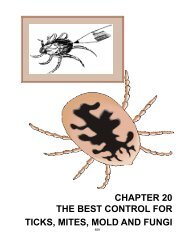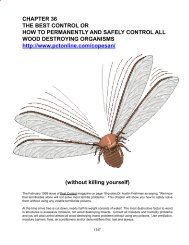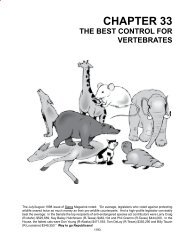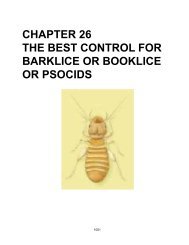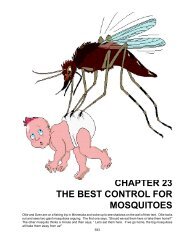chapter 16 the best control for human lice and scabies
chapter 16 the best control for human lice and scabies
chapter 16 the best control for human lice and scabies
Create successful ePaper yourself
Turn your PDF publications into a flip-book with our unique Google optimized e-Paper software.
position of nits on <strong>the</strong> hair shaft usually can distinguish between current <strong>and</strong> past infestation because<br />
female <strong>lice</strong> attach <strong>the</strong>ir eggs to <strong>the</strong> hair shaft at <strong>the</strong> scalp. In 1 week, <strong>the</strong> time it takes <strong>for</strong> a louse egg to<br />
hatch, <strong>the</strong> average <strong>human</strong> hair grows about 1/4”, carrying <strong>the</strong> egg with it. There<strong>for</strong>e, nits more than 1/4” from<br />
<strong>the</strong> scalp usually ei<strong>the</strong>r have already hatched or will never hatch. They may remain attached to <strong>the</strong> hair shaft<br />
<strong>for</strong> months, but play no role in <strong>the</strong> transmission of head <strong>lice</strong>. Simply cut out or remove <strong>the</strong>se dead or empty nits<br />
with a <strong>lice</strong> comb <strong>and</strong>/or wash with Lice R Gone ® <strong>and</strong> Tangles R Gone ® .<br />
Itching is <strong>the</strong> most common symptom (caused by <strong>the</strong> blood sucking <strong>and</strong> bacterial infections, e.g., impetigo), but<br />
many people with very light infestations may experience no initial symptoms at all. There<strong>for</strong>e, you cannot always<br />
rely on itching or frequent head scratching to detect head <strong>lice</strong>. A thorough examination of <strong>the</strong> hair <strong>and</strong> scalp is<br />
necessary to detect head <strong>lice</strong> <strong>and</strong>/or nits. Persons infested with pubic <strong>lice</strong> should be examined <strong>for</strong> accompanying<br />
venereal diseases, because <strong>the</strong>re is a strong possibility that one is present with <strong>the</strong> o<strong>the</strong>r. Persons who think<br />
<strong>the</strong>y are infested with <strong>lice</strong> should seek assistance from a physician, <strong>the</strong> health department or <strong>the</strong> school nurse<br />
<strong>and</strong> follow <strong>the</strong>ir instructions. These instructions may include a regular scheduled use of non-toxic Lice R Gone ®<br />
Shampoo, <strong>the</strong> regular use of a sauna, daily bathing, <strong>the</strong> routine laundering of bedding, clothing <strong>and</strong> towels in<br />
hot water; <strong>and</strong> <strong>the</strong> daily washing of combs <strong>and</strong> brushes in diluted Safe Solutions, Inc. enzyme cleaners <strong>and</strong>/or<br />
borax. The entire family <strong>and</strong> all close school contacts should be routinely inspected <strong>and</strong> undergo simultaneous<br />
treatment(s) if necessary. Try every non-toxic <strong>control</strong> including metal nit or flea combs <strong>and</strong> Lice R Gone ®<br />
Shampoo <strong>and</strong> Tangles R Gone ® Hair Condtioner products first.<br />
A home or school should never be sprayed, dusted or o<strong>the</strong>rwise treated with insecticide poisons even<br />
when an occupant has an active head <strong>lice</strong> infestation. Lice live on <strong>the</strong>ir host <strong>and</strong> do not hide in wall crevices<br />
<strong>and</strong> floor cracks like cockroaches <strong>and</strong> o<strong>the</strong>r household pests. Treatment of homes, schools or any o<strong>the</strong>r dwelling<br />
with insecticide poisons would, <strong>the</strong>re<strong>for</strong>e, be useless <strong>and</strong> dangerous. Cleaning of carpets, furniture, drapes,<br />
floors, etc. should be limited to simple vacuuming, or you can rinse-<strong>and</strong>-vac with enzyme or borax. Vacuuming<br />
is <strong>the</strong> safest <strong>and</strong> easiest way to remove <strong>lice</strong> or fallen hair shafts with attached nits from upholstered furniture,<br />
rugs, stuffed animals, (child) car seats, mattresses, carpets, bedrooms, mats, cots, <strong>and</strong> anything else that might<br />
have had contact with an infested child, when done - when finished vacuuming, put <strong>the</strong> vacuum cleaner bag<br />
outside in <strong>the</strong> trash. Even soap <strong>and</strong> water or borax will kill <strong>lice</strong> in bed linens, pillows, blankets <strong>and</strong> clothing if <strong>the</strong><br />
water is hot enough (130 o F.). All clothing <strong>and</strong> bedding used during <strong>the</strong> 2-day period prior to treatment should<br />
be laundered <strong>and</strong> dried in a hot dryer. Such high temperatures may be suitable <strong>for</strong> laundering purposes, but<br />
not <strong>for</strong> shampooing <strong>the</strong> head or <strong>for</strong> bathing <strong>the</strong> body. Dry heat, steam cleaning or pressing with a hot iron will<br />
also destroy all <strong>lice</strong> because <strong>the</strong>y can survive only a few minutes at 130 o F. Most home water heaters supply<br />
water at sufficient temperatures to kill <strong>lice</strong> <strong>and</strong> <strong>the</strong>ir nits. Washing in cold or lukewarm water will not harm<br />
<strong>the</strong>m. An alternative method (if you can not wash or dry clean some items) is to seal clothing <strong>and</strong> o<strong>the</strong>r articles,<br />
e.g., stuffed animals, hats, <strong>and</strong> helmets etc. in a plastic bag <strong>for</strong> 2 weeks. Place <strong>the</strong> plastic bags outdoors on a<br />
porch or deck or in <strong>the</strong> garage even if <strong>the</strong> <strong>lice</strong> hatch in <strong>the</strong> bag - <strong>the</strong>y can not survive if <strong>the</strong>y are not fed. This<br />
will also kill all <strong>lice</strong> <strong>and</strong> <strong>the</strong>ir nits or you can simply wash all infested articles with diluted enzyme cleaners <strong>and</strong><br />
borax. Combs, brushes <strong>and</strong> similar items can also be treated by soaking <strong>for</strong> 1 hour in Lice R Gone ® Shampoo<br />
or by soaking <strong>the</strong>m <strong>for</strong> 5 to 10 minutes in a pan of water heated on <strong>the</strong> stove to 130 o F., or by soaking <strong>and</strong>/or<br />
washing in diluted Safe Solutions Enzyme Cleaners with Peppermint <strong>and</strong>/or borax. Isn’t it interesting that <strong>the</strong><br />
EPA registered .5% permethrin Rid ® label <strong>for</strong> <strong>lice</strong> <strong>control</strong> on bedding <strong>and</strong> furniture warns “avoid contact with<br />
skin, eyes or clothing. “This product (poison) is not <strong>for</strong> use on <strong>human</strong>s.” Vacate room after treatment <strong>and</strong><br />
ventilate be<strong>for</strong>e reoccupying. Do not allow children or pets to contact treated area until surfaces are dry.” While<br />
<strong>the</strong> Nix ® FDA registered <strong>lice</strong> treatment with 1% permethrin (twice as much poison) says “Saturate hair <strong>and</strong> scalp<br />
(especially behind <strong>the</strong> ears <strong>and</strong> nape of <strong>the</strong> neck) <strong>and</strong> leave (<strong>the</strong> poison) on <strong>for</strong> 10 minutes!” Do you really<br />
want to use poison on your kids?<br />
Least-Toxic Head Lice Control<br />
To help identify a <strong>lice</strong> infestation, Jennifer Campbell, LPN of Bad Axe, Michigan has <strong>the</strong> following<br />
suggestion <strong>for</strong> identifying a <strong>lice</strong> infestation. Place a piece of cellophane tape, sticky side out, on <strong>the</strong><br />
index finger of your dominate h<strong>and</strong>. Taking a comb <strong>and</strong> gently lift up sections of hair checking <strong>for</strong> any<br />
movement. If you seen anything unusual on <strong>the</strong> hair or in <strong>the</strong> section, gently press <strong>the</strong> tape on <strong>the</strong><br />
object <strong>and</strong> lift off. Then remove <strong>the</strong> tape <strong>and</strong> stick it on itself, trapping <strong>the</strong> object/louse <strong>and</strong> write with a<br />
ballpoint pen on <strong>the</strong> back of <strong>the</strong> tape where <strong>and</strong> when <strong>and</strong> on whom you collected it. This should assist<br />
many in identifying whe<strong>the</strong>r <strong>the</strong> object is a piece of d<strong>and</strong>ruff or a louse.<br />
796



